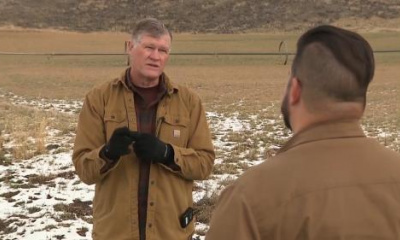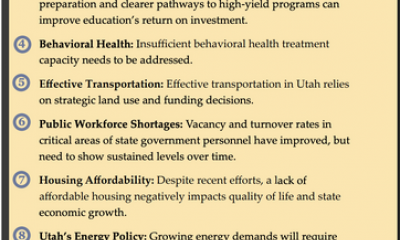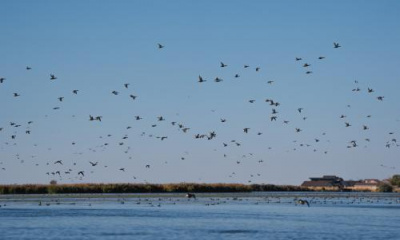Lake commissioner outlines his plan to adapt to the basin’s water shortages.
As lawmakers contemplate how to spend billions in taxpayer dollars this year, the Great Salt Lake commissioner made his case to keep investing in Utah’s imperiled lake for decades to come.
The Great Salt Lake Strategic Plan became public earlier this month, outlining a 30-year effort to get the lake back to a sustainable level. The lake currently sits about 5.5 to 8 feet lower than its minimum healthy elevation, and it hasn’t reached the healthy zone since 2002. Brian Steed, the lake commissioner, said it is possible to get the lake back off life support, but it’s going to take time, money and a lot of water conservation. And 2023′s big runoff wasn’t nearly enough to get there.
“It’s a pretty small blip in where the lake has been,” said Steed, “and where the lake probably should be.”
While lawmakers rejected the idea of setting a target elevation for the Great Salt Lake last year, Steed’s report notes the ideal range for the lake’s ecosystem and the people who depend on it lies between 4,198 and 4,205 feet above sea level. His strategic plan aims to hit at least 4,198 feet. It also largely leans on and expands policies lawmakers have already approved to rescue the lake.
Aspects of the Great Salt Lake — including its water quality, lakebed, wildlife and recreational assets — are managed by nearly a dozen state departments and divisions, along with five federal agencies. Its biggest tributary, the Bear River, flows through three different states. Steed said he intends to spend the next year working with all those interests, agencies and resource managers to better coordinate the lake’s recovery. He also will move forward with previously approved legislative mandates to monitor water quality and lakebed dust.
Dust, as Steed’s report points out, is particularly problematic. Dust poses a public health risk and also accelerates snowmelt, and scientists measured the most dust in the Wasatch Mountains on record in 2022. It melted snow 17 days earlier than normal.
The Office of Legislative Audit General, Steed noted, recently listed dust pollution as one of Utah’s critical vulnerabilities. It estimated it would take at least $15 billion to keep down the Great Salt Lake’s dust, along with $15 million each year for ongoing maintenance.
“That’s something that’s within the realm of possibility,” Steed said, “based on what we’ve seen in other terminal lakes around the country.”
Over the next five years, Steed said he intends to work with state agencies to develop a pilot program for dust control. He said he also will work on implementing the Great Salt Lake Basin Integrated Management Plan, or GSLBIP, a water budget for the watershed that is still in the works. He also will strengthen existing programs that allow water leasing and banking.
Lawmakers invested more than $250 million in both secondary metering for municipal water using and water optimization upgrades for agricultural irrigators. Steed said he plans to better monitor water conserved through those programs and track where it’s going.
“In both those cases, we probably now need to quantify how much water is being saved,” Steed said, “as well as examine opportunities for putting that water in places where it needs to be.”
With those policies in place, Steed said it’s possible to get the lake back to an elevation where its islands become islands
again, 800 square miles of lakebed are no longer exposed, industry thrives, and salinity levels support brine shrimp, brine flies and migrating birds. But it will still take a massive conservation effort for those living and working in the Great Salt Lake basin.
The strategic plan estimates it will take 1 million acre-feet of extra water each year in times of drought for the Great Salt Lake to get back to health within 30 years, and 471,000 acre-feet in normal years. For context, all agriculture in the watershed uses about 1.3 million acre-feet a year. All the cities, businesses and industry combined use about 375,000 acre-feet each year.
Why some lawmakers still want to import water to save Great Salt Lake
Sen. Scott Sandall, R-Tremonton, said he worried the Great Salt Lake watershed could become so efficient with conservation that it backfires.
“If we harden our system through conservation, we will be short-sighted completely,” Sandall said, “because when we do hit a drought, a really nasty drought the next time around, we don’t have anywhere to pull from to get water into the taps of our citizens.”
The senator encouraged Steed to work with other states to find ways to import water from other basins to augment the Great Salt Lake’s supply.
“It concerns me when I see people that just say,’ We’ve got to get water to the Great Salt Lake,’” Sandall said. “But then they turn around and they’re opposed to any kind of a pipe or any kind of transfer system that will accomplish that.”
As the lake hit record lows in 2021 and 2022, lawmakers floated the idea of a pipeline to the Pacific Ocean. A study by Brigham Young University found the proposal would cost at least $300 million a year, require the equivalent of 11% of Utah’s electricity demand, produce more emissions than 200,000 cars, and still only provide one-third of the water the Great Salt lake needs.
Steed’s strategic plan does note water imports as a possible long-term solution worth exploring. It proposes the Snake River, Missouri River and Mississippi River watersheds as other potential sources. But, the report warns, for any
proposal to realistically secure water for a sustainable lake, it will have to clear all kinds of environmental, economic, technical, political and legal hurdles.
“You’re right, there’s the potential of hardening the system through conservation,” Steed said in response to Sandall’s comments. “The good news is we’re a long ways away from that yet, so we have a lot of areas where we can still improve.”
Rep. Phil Lyman, R-Blanding, also asked whether forest management could generate more water for the lake.
“We are held hostage in Utah by the federal government,” Lyman said, “who seems intent on letting the forest just degrade and go downhill in Utah.”
Last year, Lyman’s conservative Yellow Cake Caucus promoted the idea that logging Utah’s forests, instead of water conservation, would produce enough water to solve the Great Salt Lake’s problems. The Great Salt Lake Strike Team delayed their report to lawmakers to specifically debunk that claim.
Steed is a co-chair of the strike team through his other position as executive director of the Janet Quinney Lawson Institute for Land, Water and Air at Utah State University.
“We’re actually reviewing the science on that,” Steed told Lyman. “And what we have available, there is a lot of conflicting reports out there.”
While it’s worth investing in forest management to address wildfire danger, Steed said, the Great Salt Lake plan focuses on strategies with known benefits — like removing invasive, water-guzzling phragmites that plague the lake’s wetlands.







